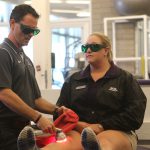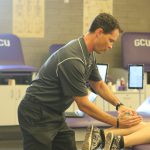- Slug: Sports-GCU Sports Medicine,600
- Photos available (thumbnails, captions below)
By BEN HALVERSON
Cronkite News
PHOENIX – Grand Canyon University has invested millions of dollars in transitioning its athletic programs to NCAA Division I.
The school has upgraded its coaching staff, its athletic facilities and now, is in the process of upgrading its sports medicine department.
Amanda Beers, a GCU student who works in sports medicine, said there are advantages to taking part in building a program at the highest level of college athletics.
“Because we’re a growing program, everyone gets to grow together,” Beers said. “(Students) get to give a lot of input.”
And the school’s sports medicine department is about to grow even more.
GCU is in the process of expanding the school’s sports medicine facility to include advanced features such as a hydrotherapy room, cryotherapy, underwater treadmills and more, according to Geordie Hackett, Grand Canyon’s director of sports medicine.
The expansion will add 2,500 feet of space to school’s current facility and will cost between $500,000 and $1 million, Hackett said. It is expected to be completed in May of 2017.
“People are going to come in here and that’s going to be the ‘wow’ factor,” Hackett said.
Hackett has been with Grand Canyon’s sports medicine program since 2005 and designed the current medical facility six years ago.
He uses advanced medical practices, such as Fusionetics, a human performance system that utilizes a series of tests to record the functions of an individual’s body. The program uses technology to focus on the athlete’s needs for improved recovery, optimized performance and injury prevention.
The platform allows athletes to pinpoint what areas of the body need strengthening, stretching or development, according to Hackett. And it allows the medical staff and the athlete to become more efficient as the program prepares a training regimen focusing on the areas of concern.
Fusionetics, along with the other advanced medical technology used by Hackett, can give Grand Canyon an advantage with athletes the school is recruiting.
“The recruits come in and I show them the Fusionetics story,” Hackett said. “We have a (basketball) recruit, Fiifi (Aidoo) from Finland. I showed him the Fusionetics platform, and he decided to come here.”
Aniya Baker, a senior point guard on the women’s basketball team, said Fusionetics and the technology utilized by the GCU medical staff has helped her in her recovery and performance as an athlete.
“During the season, sometimes your body breaks down and stuff like this helps you recover,” Baker said. “(The staff) works very well together. They do their best to communicate so we feel the best we can to compete.”
Having played three years of collegiate soccer, Hackett draws on his experience as an athlete to understand and recognize the needs of his athletes. Hackett has been around some of the best healthcare as a student-athlete, which helps him understand the benefits of a state-of-the-art medical staff and facility.
According to Hackett, Grand Canyon’s sports medicine department can rival some of the best physical therapy clinics, athlete performance facilities, and physical therapy facilities. He attributes the department’s success to support from the school’s executive team.
As GCU prepares for full NCAA Division I status during the 2017-2018 academic year, the Lopes hope to remain ahead of the curve and continue to build their sports medicine department as they strive to be a top-shelf overall athletic program.
“Our name is getting out there,” Hackett said. “We’re growing in terms of marketing, exposure, things like that. The size of the school is growing. We’re kind of like the underdog. But what people don’t realize until they get here is the standard of care we offer can rival that of top-25 schools.”

